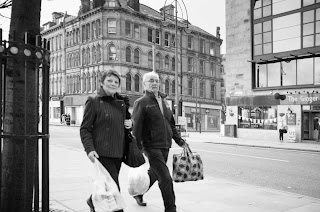Time moves on, it doesn’t stand still, inexorably the grains of sand denote from one moment to the next how the transience of the “present” is turned into the vast sweep of history and how the present lasts shorter than we able to capture. Carpe Diem. There is only future and past, the present is too transitory, too fickle to engage with us long enough to register, what we think is now has gone by the time we register it’s presence in any medium. Our currency as photographers, is to anticipate the future and to deliver its consequence to the past with context. The trade we make as we press the shutter release is with the perspective we provide to the viewer of our own connection with time passing.
Perspectives of history, our personal history are also analogues, we review, we re-write, we add and subtract information to and from our memories distorting and embellishing the view of our times past. I see the past episodically, in banks of memory; the memory starts, the memory finishes – memory remembered, memory faded. The memory is also prone to the vagaries of connection; sometimes the memory is bright, full of colour, of noise, of activity, of joy; sometimes not. Sometimes the memory fades in and out, part of a name, part of a scene, part of a journey. Like the early experimental television links, it isn’t reliable.
Film is a memory, memory is a memory, they both capture a period of time and succeed in something that the conscious mind has difficulty in doing – that is recording the period and holding the veracity of that moment for perpetuity. Whatever the camera, whatever the medium, whatever is captured is memorized for as long as the medium doesn’t fail or degrade, though the decrepidation of memory is another aspect of how a image could be presented, but not not what this post is about.
If everything is constantly in a state of flux and has movement (apart from the oxymoronic genre “still life”), if what we capture in a viewfinder is going to be a memory as soon as it is captured, then my question is how can this be best depicted?
Some time ago I saw a set of seascapes by, I think, Sugimoto, though I may be wrong. Placid vistas of calm grey seas set against a cold grey, almost featureless sky. I found them beautiful but passive, inscrutable but not fearful ‘scapes, whose energy could only be described by me as potential. Wonderful records in a depleted tonal palette, the sea might have depth, it could also be shallow – there were no clues, it was up to me, the viewer, to bring to the image what I have, as an emotion, to the photograph. The very slight swell on the surface of the water prohibited the interrogation of the image – it held me afar, only to glory in it’s transcendent beauty that was clear, on the surface of the water, on the surface of the print. I remember the beauty of the image, the serenity. Maybe my understanding was less but it I remember only the two dimensionality of the image
Movement, “un-still life” has the potential to present energy and emotion and the one of the best examples of this I've seen can be found in Chris Friel’s photographs. A (colour blind) painter, Friel turned to photographry some six or seven years ago and hasn't painted since.
 |
| From the "Sea" series. Reprinted by kind permission of the artist Chris Friel |
 |
| "Sea of blood 6". Reprinted by kind permission of the artist Chris Friel |
These images express very graphically the energy of the ocean, it doesn’t seem like a sea, it is too "big" to be a sea as in Sugimoto's photographs. This ocean has a ferocious majesty that would seem to defy any physical entity to try and tame it. There is a huge power in the way the movement rolls and swirls, lifts and breaks. With his use of motion blur Friel seems to capture not only the movement of this elemental force but also to trigger my memory of storms, it invokes within me the strength I have seen in the ocean unrest and the fear I felt when seeing it. It is the memory of it that I find most disconcerting, most significant. Friel not only captures the movement but his images seem to invoke the memory or emotion of a place.
 |
| "Sea of blood 2". Reprinted by kind permission of the artist Chris Friel |
The notion that a photograph can invoke, maybe even record a memory is something that I've looked at before in Stefano Bernadoni's work. link to the previous entry here
 |
| From the "memory of the places" by Stefano Bernardoni reprinted by kind permission of the artist |
Bernardoni utilises blur here I think to denote the un-surety of memory. The memory is almost delivering, but some of the detail is missing, it isn't as sharp as we might like, but maybe this lack of clarity warms the memory. Whereas Friel applies blur, movement as well as physically altering the surface of the image with scratches to challenge our perception of the static image whilst probing for an emotional response from the viewer.
 |
| Untitled. Reprinted by kind permission of the artist Chris Friel |
 |
| "Church". Reprinted by kind permission of the artist Chris Friel |
Memory and the notion of time are also invoked in these images from Friel. Nothing is clear. It maybe that Friel is colour blind but his colourisation, especially of these first two opposite images - clearly the same subject - invoke different memories.
 |
| "Castle 1". Reprinted by kind permission of the artist Chris Friel |
Moving pictures is available from Blurb and contains most of the images above by Chris Friel
Chris Friel's Flickr site is here










































